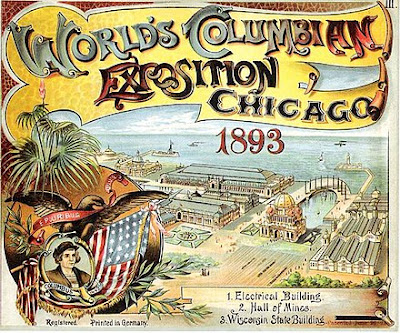At one point in my book, Phoebe, part of the Christmas Quilt Brides series, the following conversation takes place:
(Phoebe): “Do you remember the World’s Columbian Exhibition held in 1893? Did you have the opportunity to view it?”
“The Chicago World’s Fair? I was aware of it taking place. Unfortunately, my sister and I were busy with preparing for and participating in the Land Run at that same time, so I was unable to attend.” Her tone slightly acerbic, Marigold kept her gaze on her stitching.
“Oh.” Wondering if she had said something wrong, Phoebe swallowed. Then again, 1893 had been the year the great financial panic they were still experiencing had started. Perhaps the two Calloway sisters had been negatively affected to the point that the expense of visiting the exhibition was prohibitive.
Although the above snippet is from a scene that takes place in 1896, my grouping of four books from two multi-author projects set in New Ponca, Oklahoma Territory, starts by featuring the Cherokee Strip and Cherokee Outlet Land Run of 1893 (Joshua’s Bride). I decided to feature 1893, since for many Americans, it was a year of highs and lows.
On March 4 – The presidential term for Benjamin Harrison ended. At that point, Grover Cleveland took office as U.S. President.
On May 1 – the 1893 World’s Fair, better known at the time as the World’s Columbian Exposition, opened to the public in Chicago, Illinois. The fair remained open through October. The first U.S. commemorative postage stamps and coins were issued for this exposition.
The 1896 Broadway melodrama The War of Wealth was inspired by the panic of 1893
On May 5 – A crash on the New York Stock Exchange started a depression. A precursor to this financial downturn was the passage of the Sherman Silver Purchase Act in 1890. This law required the U.S. Treasury to buy silver with a special issue of Treasury Notes (Coin) that could that could be redeemed for either silver or gold. This created a substantial expansion in the volume of circulating dollars without a proportionate growth in the gold stock. The crash in the silver dollar's bullion value in the 1890s from 80 cents to approximately 50 cents increased public anxiety on their continued ability to convert silver dollars and banknotes into gold. The result was a run on the Treasury's gold stock.
Although the country had experienced economic depressions on a regular basis every decade or two, the Panic of 1893, as it came to be known, was particularly intense. It continued through 1896.
On July 22 – After having admired the view from the top of Pikes Peak near Colorado Springs, Colorado, Katharine Lee Bates wrote the patriotic song, “America the Beautiful,” still frequently sung today.
On August 7 – the Sherman Silver Purchase Act was repealed.
On August 19 – President Cleveland finally issues the proclamation for the Cherokee Strip Land Run.
On August 27 – The Sea Islands Hurricane struck Savanah, Charleston, and the Sea Islands, killing between 1,000 and 2,000 people.
On September 19 – The 1893 Cherokee Strip Land Run began.
The change in presidential administrations in March became a significant factor for many low-income Americans desperate for land. The previous Harrison administration had approved earlier land runs in what had been Indian Territory, and which was intended to become part of the new Oklahoma Territory, formed after the first large run on 1889. This administration also started the process of acquiring the land in what was known as the Cherokee Strip and Cherokee Outlet for an additional land run. The Cherokee Outlet was not part of the Cherokee reservation, but it was west of their reservation land and controlled by the Cherokee tribe, who leased it out to cattlemen, many of them white Americans. The land was vacated, but the process stalled once Cleveland came into office. Many land-starved Americans waited impatiently for the opportunity to claim farm land.
On September 21 – Brothers Charles and Frank Duryea drive the first gasoline-powered motorcar in America on public roads in Springfield, Massachusetts. The following is another excerpt from my upcoming book. The scene is between my hero, Graham, and his father:
“Automobiles? You mean those glorified velocipedes that bounce around on bicycle tires and are powered by a one-cylinder engine? I’ve seen a few around the city, and I’m not favorably impressed. Especially with their tendency to backfire, they make too much noise, which scares the horses and creates havoc in the streets. They break down too often, too.” Richard shook his head. “They are a temporary novelty, Son. Before long, the phase will pass.”
“I don’t believe so, Father. They have their good points. They do not need daily feeding and maintenance, like horses or mules. No mucking out stalls, and no animal droppings on the street.” Graham had raised his eyebrows with a knowing look.
“Perhaps not, but that engine exhaust can be almost as noxious as a street full of horse apples. As for going any distance, the tires do not hold up while traveling the rough roads, especially between towns. Automobiles will end up being nothing more than aggrandized toys.” Richard dismissed the topic with a fling of his hand through the air.
On December 8 – The National Education Association releases the final report from the “Committee of Ten” at the Columbia University conference recommending standardization of the high school curriculum.
This is a partial list of events for 1893. More can be found on Wikipedia by CLICKING HERE
Although not all of
the above events of 1893 played a role in my next historical romance, Phoebe,
several did. This book is now on pre-order and scheduled for release on
November 15, 2024.
To find the book description and pre-order link, please CLICK HERE








No comments:
Post a Comment